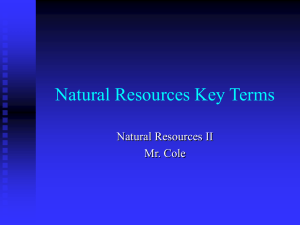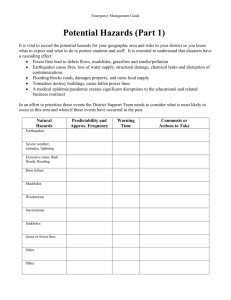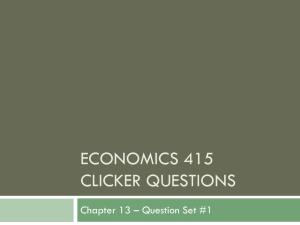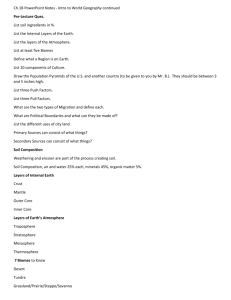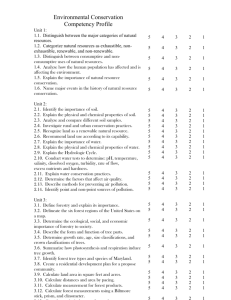APPENDIX I - Springer Static Content Server
advertisement
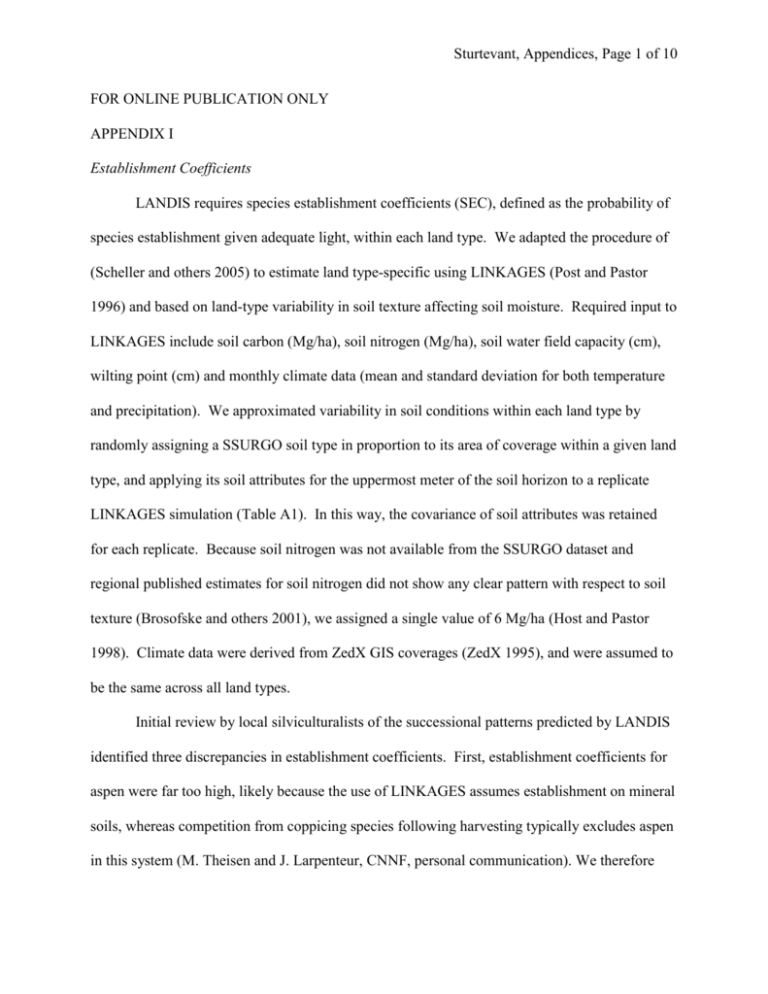
Sturtevant, Appendices, Page 1 of 10 FOR ONLINE PUBLICATION ONLY APPENDIX I Establishment Coefficients LANDIS requires species establishment coefficients (SEC), defined as the probability of species establishment given adequate light, within each land type. We adapted the procedure of (Scheller and others 2005) to estimate land type-specific using LINKAGES (Post and Pastor 1996) and based on land-type variability in soil texture affecting soil moisture. Required input to LINKAGES include soil carbon (Mg/ha), soil nitrogen (Mg/ha), soil water field capacity (cm), wilting point (cm) and monthly climate data (mean and standard deviation for both temperature and precipitation). We approximated variability in soil conditions within each land type by randomly assigning a SSURGO soil type in proportion to its area of coverage within a given land type, and applying its soil attributes for the uppermost meter of the soil horizon to a replicate LINKAGES simulation (Table A1). In this way, the covariance of soil attributes was retained for each replicate. Because soil nitrogen was not available from the SSURGO dataset and regional published estimates for soil nitrogen did not show any clear pattern with respect to soil texture (Brosofske and others 2001), we assigned a single value of 6 Mg/ha (Host and Pastor 1998). Climate data were derived from ZedX GIS coverages (ZedX 1995), and were assumed to be the same across all land types. Initial review by local silviculturalists of the successional patterns predicted by LANDIS identified three discrepancies in establishment coefficients. First, establishment coefficients for aspen were far too high, likely because the use of LINKAGES assumes establishment on mineral soils, whereas competition from coppicing species following harvesting typically excludes aspen in this system (M. Theisen and J. Larpenteur, CNNF, personal communication). We therefore Sturtevant, Appendices, Page 2 of 10 reduced establishment coefficients for aspen on all land types by 95%, which assumes that nearly all aspen reproduction is vegetative. Second, the establishment coefficients for three species associated with nutrient rich sites (sugar maple, yellow birch, and white ash) were perceived to be too high for the drier land types, probably due to our assumptions about soil nitrogen. We therefore reduced establishment coefficients for these three species on drier land types so that their proportional relationship with the coefficient for the richest land type (FR4) was the same as American basswood, which has similar soil moisture and nutrient requirements (Burns and Honkala 1990). Finally, oak regeneration is encouraged in the national forest using prescribed burning in the three driest land types. Because the harvest module could not adequately target oak stands for “burn” treatments, we accounted for this activity by adjusting establishment coefficients. CNNF forest management zones were overlaid with the land type map, and oak establishment coefficients were increased within managed portions of the three driest land types in proportion to the decadal target area of prescribed burning for each management zone (3.5% 3C, 3.2% 4A, 4.8% 4B). Forest composition targets for forest management zones are described in Table 5. Establishment coefficients of all other species were reduced by the same proportions in these areas. Given those three adjustments, species establishment coefficients resulted in successional patterns consistent with the experience of the CNNF silviculturalists (M. Theissen and J. Larpenteur, CNNF, personal communication). Sturtevant, Appendices, Page 3 of 10 Table A1. Soil Parameters (Means with Standard Deviations in Parentheses) used in LINKAGES Simulations to Estimate Species Establishment Coefficients for Each of 4 Forested Land Types (Fig. 2 a), Rank-ordered According to Relative Soil Moisture. N Soil Carbon (mg/ha) Wilting Point Field Capacity 17 62.14 (5.08) 5.23 (0.45) 13.22 (0.94) 32 54.72 (5.04) 6.19 (0.40) 14.55 (0.79) 36 64.07 (4.98) 6.70 (0.38) 16.13 (0.81) 49 64.98 (5.39) 7.68 (0.32) 18.28 (0.77) Table A2. Species Establishment Coefficients Estimated using Linkages Species Abies balsamea Acer rubrum Acer saccharum Betula alleghaniensis Betual papyrifera Carya cordiformis Fraxinus americana Picea glauca Pinus banksiana Pinus resinosa Pinus strobus Populus grandifolia Populus tremuloides Prunus serotinous Quercus alba Quercus ellisoidalis Quercus rubra Thuja occidentalis Tillia americana Tsuga canadensis FR1 0.12 0.74 0.32 (0.06) 0.20 (0.03) 0.58 0.18 0.32 (0.07) 0.12 0.86 0.04 0.18 0.94 (0.04) 0.88 (0.04) 0.22 0.00 0.46 0.10 0.04 0.04 0.00 FR2 0.18 0.68 0.24 (0.12) 0.14 (0.07) 0.72 0.08 0.32 (0.14) 0.24 0.82 0.10 0.30 0.90 (0.05) 0.88 (0.04) 0.38 0.00 0.48 0.14 0.20 0.08 0.02 FR3 0.32 0.90 0.32 (0.31) 0.20 (0.16) 0.80 0.12 0.54 (0.35) 0.32 0.96 0.26 0.30 1.00 (0.05) 0.98 (0.05) 0.36 0.00 0.56 0.18 0.18 0.20 0.06 FR4 0.38 0.52 0.28 0.88 0.06 0.60 0.54 0.96 0.48 0.40 0.96 (0.05) 1.00 (0.05) 0.60 0.00 0.64 0.40 0.40 0.34 0.10 Sturtevant, Appendices, Page 4 of 10 Numbers in parentheses represent values adjusted based on the expert opinion of local silviculturalists. APPENDIX 2. Fire and Fuel Parameterization Fuel Parameterization The fuel module of LANDIS 4.0 uses a series of look-up tables to assign coarse and fine fuels into five rank-ordered classes (He and others 2004). We parameterized the fuel module so that fuel types were a simple function of the species age cohorts present on a cell, where the resulting fuel classes corresponded to BEHAVE fuel models (Andrews 1986) based on the local experience of fire management officers (J. Grant and J. Saunders, CNNF, personal communication). The resulting fuel types affected spread rates, fire initiation probabilities, and fire severity class (Table 1). With the exception of young pine plantations, the spread rates are based on surface fire behavior that dominates the local fire regime. Fire Weather and Spread The fire module selects fire weather conditions for each event from a user-defined distribution. Fire season (that is, April and May (Cardille and Ventura 2001)) wind statistics from a local weather station were used to define probabilities for different wind directions and 5 classes of wind speed representing low to extreme fire weather conditions for the region. We removed the lowest wind speed class (5 mph) from the distribution because fires started under very low wind conditions are generally smaller than the cell size of the study area (J. Grant, CNNF, personal communication). For each BEHAVE fuel model represented in Table 1, fire spread rates were estimated using the BehavePlus fire modeling system (Andrews and others 2005) for each remaining wind class (that is, 8, 16, 24, and 32 km per hour). In the one case where a LANDIS fuel class represented two BEHAVE fuel models (that is, class 2, Table 1) we Sturtevant, Appendices, Page 5 of 10 averaged spread rates for the two fuel models. Burn shapes generated by the LANDIS fire module were then calibrated to match the burn shapes generated by Farsite using the relative weight of wind versus fuel type on spread rates, so that fire shapes simulated by the two models had the greatest statistical equivalence under a range of fuel configurations (B. Miranda, unpublished manuscript). Fire Regime A 16-year fire database for northern Wisconsin (Cardille and Ventura 2001) was used to parameterize the fire regime expected under current fire suppression policies. Sturtevant and Cleland (2007) found that housing densities above 2.09 km2 significantly increased fire occurrence in the region. Using the entire region analyzed by Sturtevant and Cleland (2007), we divided the land types into low and high density housing areas corresponding with 1990 housing densities above and below that threshold, respectively. Fire start density and mean fire size were estimated for each housing density-land type combination, using the cover type assigned to each fire to separate forest, open, and wetland fires (Table 2). The fire cause recorded in the database was used to separate fire starts attributed to debris burning and road-related causes (Figure A1). Roads were represented as 30m wide (that is, one pixel-width) semi-permeable barriers to fire spread. Fires can cross roads at randomly placed crossing points (pixels) that vary in their linear density according to the road class (Table 3; Alan Harrison, CNNF, personal communication). Road-related fire starts from the fire database were used to parameterize the relative increase of ignition frequency within cells bordering roads, so that the combination of roads, land types, and housing density spatially defined the fire regime (Figure 2 b). The fire regime for the Lakewood area was approximated by fitting two fire size distributions: small fires less than or equal to 50 acres (20 ha) representing “contained fires”, Sturtevant, Appendices, Page 6 of 10 and large fires larger than 50 acres (20 ha) representing “escaped fires”. Fire regime statistics (that is, ignition rates and mean return intervals) were first calculated for each land type / housing density combination using small fire observations from the fire database. Ignition parameters were calibrated to account for fuel-specific fire initiation probabilities (Table 2) and then fire duration parameters were calibrated to approximate the mean fire return interval based on small fire observations – both calibrations were performed for each land type / housing density combination. We averaged results from 4 replicates each consisting of 25 simulations of the first decade of the base scenario to estimate ignition rates and mean fire rotations representative of current landscape conditions. Input ignition rates and durations were then calibrated until at least 3 consecutive evaluations resulted in ignition rates and MRIs within +/15% of the target, with at least 1 replicate showing positive difference and 1 showing negative difference. An exception was the swamp hardwood land type, which had too small an area to meet these criteria. The large inherent variability in the model made it unrealistic to achieve more precise results consistently for all land types. Large fires were represented by 64 out of 7747 (that is, 0.875%) total fire observations in the fire database, with a maximum size of 1210 acres (490 ha). Given the rarity of such events, we made no assumptions about where large (escaped) fires would occur within the landscape. Instead, we made three assumptions regarding large fires: (a) large fires occur with the same frequency (0.875%) observed in fire database, (b) large fires only occur during very high or extreme fire weather conditions, and (c) fires cannot escape control within the deciduous, nonoak fuel type (that is, LANDIS fuel class 1; Table 1). Wind directions for large fires were calculated using the proportions observed for very high and extreme weather conditions. The mean fire return interval for the entire Lakewood study area was estimated as the area-weighted Sturtevant, Appendices, Page 7 of 10 average of all mean fire return intervals calculated for the land type / housing density combinations (Table 2). Durations of large fires were selected from separate distributions calibrated by increasing the means until the landscape-scale mean fire return interval reached the landscape-scale target estimated using all fire records (Table 2). The combined small and large fire size distribution simulated for the Lakewood study area was very similar to that observed for northern Wisconsin (Figure A2). Literature Cited Andrews, PL. 1986. BEHAVE: Fire behavior prediction and fuel modeling system-BURN subsystem, Part 1. U.S. Department of Agriculture, Forest Service, Intermountain Research Station,General Technical Report INT-194. Ogden, UT, 130. Andrews, PL, Bevins CD, Seli RC. 2005. BehavePlus fire modeling system, version 4.0: User's Guide. U.S. Department of Agriculture, Forest Service, Rocky Mountain Research Station,General Technical Report RMRS-106. Ogden, UT, 132. Brosofske, KD, Chen J, Crow TR. 2001. Understory vegetation and site factors: Implications for a managed Wisconsin landscape. Forest Ecology and Management 146: 75-87. Burns, RM, Honkala BH. 1990. Silvics of North America: 1. Conifers; 2. Hardwoods. U.S. Department of Agriculture, Forest Service Agriculture Handbook. Cardille, JA, Ventura SJ. 2001. Occurrence of wildfire in the northern Great Lakes region: Effects of land cover and land ownership assessed at multiple scales. International Journal of Wildland Fire 10: 145-154. Didion, M, Fortin MJ, Fall A. 2007. Forest age structure as indicator of boreal forest sustainability under alternative management and fire regimes: A landscape level sensitivity analysis. Ecological Modelling 200: 45-58. Sturtevant, Appendices, Page 8 of 10 Finney, MA. 2002. Fire growth using minimum travel time methods. Canadian Journal of Forest Research 32: 1420–1424. He, HS, Shang BZ, Crow TR, Gustafson EJ, Shifley SR. 2004. Simulating forest fuel and fire risk dynamics across landscapes - LANDIS fuel module design. Ecological Modelling 180: 135-151. Host, G, Pastor J. 1998. Modeling forest succession among ecological land units in northern Minnesota. Conservation Ecology 2: 15. Pennanen, J, Kuuluvainen T. 2002. A spatial simulation approach to natural forest landscape dynamics in boreal Fennoscandia. Forest Ecology and Management 164: 157-175. Post, WM, Pastor J. 1996. LINKAGES - An individual-based forest ecosystem model. climatic change 34: 253-261. Scheller, RM, Mladenoff DJ, Thomas RC, Sickley TA. 2005. Simulating the effects of fire reintroduction versus continued fire absence on forest composition and landscape structure in the Boundary Waters Canoe Area, northern Minnesota, USA. Ecosystems 8: 396-411. Sturtevant, BR, Cleland DT. 2007. Human and biophysical factors influencing modern fire disturbance in Northern Wisconsin. International Journal of Wildland Fire 16: 398–413. Yang, J, He HS, Gustafson EJ. 2004. A Hierarchical Fire Frequency Model to Simulate Temporal Patterns of Fire Regimes in Landis. Ecological Modelling 180: 119-133. Yang, J, He HS, Sturtevant BR, Miranda BR, Gustafson EJ. 2008. Comparing the effects of fire modeling methods on simulated fire patterns and succession: A case study in the Missouri Ozarks. Canadian Journal of Forest Research 38: 1290-1302. Sturtevant, Appendices, Page 9 of 10 Sturtevant, Appendices, Page 10 of 10 Figure Legends Figure A1. Fire occurrence rates (a) and burn rates (b) by land type / housing density combinations, separated according to debris, road, and other causes. Figure A2. a. Calibrated fire size distribution for the Lakewood study area, compared with the raw fire size statistics from northern Wisconsin. Note that fires less than 0.04 ha in size (that is, less than 75% of a pixel) were removed from the distribution, and that the y-axis is on a log scale. Proportional area in each land type and housing density class (Table 2) is similar between the northern Wisconsin region and the Lakewood study area. b. The CNNF considers fires larger than 20 ha (50 ac) to have “escaped suppression”. c. Additional “large” fires needed to be added to extend the tail of the simulated fire size distribution.
